Mahendras has started special quizzes for IBPS | RBI | SBI | NABARD Exam so that you can practice more and more to crack the examination. IBPS | RBI | SBI | NABARDspecial quiz series will mold your preparations in the right direction and the regular practice of these quizzes will be really very helpful in scoring good marks in the Examination. Here we are providing you the important question of reasoning ability for the IBPS | RBI | SBI | NABARD Exam.
Q.1-5 Study the given information carefully and answer the following questions.
Seven sons Pramod, Qutub, Rohit, Suman, Tarun, Ujjwal and Varun are born in the month of March in different years. Their ages are calculated on the same month with respect to 2018.
Note: If it is mentioned that a son’s age is considered as the last two digits of another son’s birth year, then it will be at any sequence. For example, if the age of Ravi is considered as last two digits of birth year of Yash which is 1965; then the age of Ravi might be either 65 or 56.
None of the sons was born before 1974 and after 2008. Pramod was born in 1998. The difference between the age of Pramod and Tarun is 5 years. Rohit’s age is equal to the last two digits of birth year of Tarun and his age is not an even number. Ujjwal’s age is a square number between Tarun’s age and Rohit’s age. Suman’s age is half of the age of Varun’s age whose age is last two digits of Ujjwal’s birth year. The sum of ages of Pramod and Suman is two more than that of the age of Qutub.
दी गई जानकारी का ध्यानपूर्वक अध्ययन करें और निम्नलिखित प्रश्नों के उत्तर दें।
सात पुत्र प्रमोद, कुतुब, रोहित, सुमन, तरुण, उज्जवल और वरुण अलग-अलग वर्षों में मार्च के महीने में पैदा हुए हैं। उनकी आयु की गणना 2018 के संबंध में एक ही महीने में की जाती है।
नोट: यदि यह उल्लेख किया गया है कि एक पुत्र की उम्र को दूसरे पुत्र के जन्म वर्ष के अंतिम दो अंक के रूप में माना जाता है, तो यह किसी भी अनुक्रम में होगा। उदाहरण के लिए, यदि रवि की आयु यश के जन्म वर्ष जो 1965 है; के अंतिम दो अंक मानी जाती है तो रवि की उम्र 65 या 56 हो सकती है।
1974 से पहले और 2008 के बाद में कोई भी पुत्र पैदा नहीं हुआ था। प्रमोद का जन्म 1998 में हुआ था। प्रमोद और तरुण की उम्र में 5 साल का अंतर है। रोहित की उम्र, तरुण के जन्म वर्ष के अंतिम दो अंकों के बराबर है और उसकी उम्र एक सम संख्या नहीं है। उज्जवल की आयु, तरुण की आयु और रोहित की आयु के बीच की एक वर्ग संख्या है। सुमन की आयु, वरुण की आयु की आधी है जिसकी आयु उज्जवल के जन्म वर्ष के अंतिम दो अंक हैं। प्रमोद और सुमन की उम्र का योग कुतुब की उम्र से दो अधिक है।
Q.1 What is the age of Suman?
(1) 16 years
(2) 14 years
(3) 22 years
(4) 38 years
(5) None of these
सुमन की उम्र क्या है?
(1) 16 साल
(2) 14 साल
(3) 22 साल
(4) 38 साल
(5) इनमें से कोई नहीं
Q.2 Which of the following year is the birth year of Ujjwal?
(1) 1984
(2) 1993
(3) 2000
(4) 1982
(5) None of these
निम्नलिखित में से कौन-सा वर्ष उज्जवल का जन्म वर्ष है?
(1) 1984
(2) 1993
(3) 2000
(4) 1982
(5) इनमें से कोई नहीं
Q.3 If William was born between Rohit and Ujjwal then which of the following can be the birth year of William?
(1) 1980
(2) 1990
(3) 1982
(4) 1985
(5) None of these
यदि विलियम का जन्म रोहित और उज्जवल के बीच हुआ था, तो निम्नलिखित में से कौन-सा विलियम का जन्म वर्ष हो सकता है?
(1) 1980
(2) 1990
(3) 1982
(4) 1985
(5) इनमें से कोई नहीं
Q.4 What will be the sum of ages of Second youngest and Third eldest son in the group?
(1) 55 years
(2) 52 years
(3) 60 years
(4) 49 years
(5) None of these
समूह में दूसरे सबसे छोटे और तीसरे सबसे बड़े पुत्र की उम्र का योग क्या होगा?
(1) 55 साल
(2) 52 साल
(3) 60 साल
(4) 49 साल
(5) इनमें से कोई नहीं
Q.5 Which of the following statement is true?
(1) Ujjwal is younger than Qutub.
(2) Tarun is three years elder than Varun.
(3) None of the options is true
(4) Suman is not the youngest son.
(5) The number of sons born after Qutub is same as before Tarun.
निम्नलिखित में से कौन-सा कथन सत्य है?
(1) उज्जवल कुतुब से छोटा है।
(2) तरुण वरुण से तीन साल बड़े हैं।
(3) कोई भी विकल्प सही नहीं है
(4) सुमन सबसे छोटा पुत्र नहीं है।
(5) कुतुब के बाद और तरुण से पहले पैदा हुए पुत्रों की संख्या समान है।
Q.6 In each question given below four statements are followed by two conclusions numbered I and II. You have to take the three given statements to be true (even if they seem to be at variance from the commonly known facts). Read the conclusions and decide which logically follows.
Statements:
All trees are jungles.
All jungles are houses.
All houses are buildings.
All buildings are villages.
Conclusions:
I. All villages being trees is a possibility.
II. All trees being villages is a possibility.
Give answer-
(1) If only conclusion I follows.
(2) If only conclusion II follows.
(3) If either conclusion I or II follows.
(4) If neither conclusion I nor II follows.
(5) If both conclusions I and II follow.
नीचे प्रत्येक प्रश्न में तीन कथन व दो निष्कर्ष I और II दिए गए हैं। आपको दिये गये तीनों कथनों को सही मानना है (चाहे वे सामान्यतया सही तथ्यों से भिन्न क्यों न हों)। निष्कर्षों को पढ़ें और और यह तय करें कि कौन से निष्कर्ष तार्किक रूप से अनुसरण करते हैं।
कथन:
सभी पेड़, जंगल हैं।
सभी जंगल घर हैं।
सभी घर, इमारत हैं।
सभी इमारत, गांव हैं।
निष्कर्ष:
I. सभी गांव के पेड़ होने की एक संभावना है।
II. सभी पेड़ के गांव होने की एक संभावना है।
उत्तर दीजिये-
(1) यदि निष्कर्ष I अनुसरण करता है।
(2) यदि निष्कर्ष II अनुसरण करता है।
(3) यदि या तो निष्कर्ष I या II अनुसरण करता है।
(4) यदि न तो निष्कर्ष I न ही II अनुसरण करता है।
(5) यदि निष्कर्ष I और II दोनों अनुसरण करते हैं।
Q.7 In each question given below four statements are followed by two conclusions numbered I and II,. You have to take the three given statements to be true (even if they seem to be at variance from the commonly known facts). Read the conclusions and decide which logically follows.
Statements:
All trees are jungles.
All jungles are houses.
All houses are buildings.
All buildings are villages.
Conclusions:
I. All houses being jungles is a possibility.
II. All buildings being houses is a possibility.
Give answer-
(1) If only conclusion I follows.
(2) If only conclusion II follows.
(3) If either conclusion I or II follows.
(4) If neither conclusion I nor II follows.
(5) If both conclusions I and II follow.
नीचे प्रत्येक प्रश्न में तीन कथन व दो निष्कर्ष I और II दिए गए हैं। आपको दिये गये तीनों कथनों को सही मानना है (चाहे वे सामान्यतया सही तथ्यों से भिन्न क्यों न हों)। निष्कर्षों को पढ़ें और और यह तय करें कि कौन से निष्कर्ष तार्किक रूप से अनुसरण करते हैं।
कथन:
सभी पेड़, जंगल हैं।
सभी जंगल घर हैं।
सभी घर, इमारत हैं।
सभी इमारत, गांव हैं।
निष्कर्ष:
I. सभी घर के जंगल होने की एक संभावना है।
II. सभी इमारत के घर होने की एक संभावना है।
उत्तर दीजिये-
(1) यदि निष्कर्ष I अनुसरण करता है।
(2) यदि निष्कर्ष II अनुसरण करता है।
(3) यदि या तो निष्कर्ष I या II अनुसरण करता है।
(4) यदि न तो निष्कर्ष I न ही II अनुसरण करता है।
(5) यदि निष्कर्ष I और II दोनों अनुसरण करते हैं।
Q.8 In each question given below four statements are followed by two conclusions numbered I and II,. You have to take the three given statements to be true (even if they seem to be at variance from the commonly known facts). Read the conclusions and decide which logically follows.
Statements:
All cups bowls.
All bowls are trays.
Some trays are plats.
No plats is spoon.
Conclusions:
I. Some cups being plates is a possibility.
II. All cups being spoon is a possibility.
Give answer-
(1) If only conclusion I follows.
(2) If only conclusion II follows.
(3) If either conclusion I or II follows.
(4) If neither conclusion I nor II follows.
(5) If both conclusions I and II follow.
नीचे प्रत्येक प्रश्न में तीन कथन व दो निष्कर्ष I और II दिए गए हैं। आपको दिये गये तीनों कथनों को सही मानना है (चाहे वे सामान्यतया सही तथ्यों से भिन्न क्यों न हों)। निष्कर्षों को पढ़ें और और यह तय करें कि कौन से निष्कर्ष तार्किक रूप से अनुसरण करते हैं।
कथन:
सभी चषक, प्याला है।
सभी प्याला, थाली है।
कुछ थाली, प्लेट हैं।
कोई प्लेट, चम्मच नहीं है।
निष्कर्ष:
I. कुछ चषक के प्लेट होने की एक संभावना है।
II. सभी चषक के चम्मच होने की एक संभावना है।
उत्तर दीजिये-
(1) यदि निष्कर्ष I अनुसरण करता है।
(2) यदि निष्कर्ष II अनुसरण करता है।
(3) यदि या तो निष्कर्ष I या II अनुसरण करता है।
(4) यदि न तो निष्कर्ष I न ही II अनुसरण करता है।
(5) यदि निष्कर्ष I और II दोनों अनुसरण करते हैं।
Q.9 In each question given below four statements are followed by two conclusions numbered I and II,. You have to take the three given statements to be true (even if they seem to be at variance from the commonly known facts). Read the conclusions and decide which logically follows.
Statements:
All plastics are glasses.
All sponges are glasses.
Some sponges are clothes.
All liquides are clothes.
Conclusions:
I. All glasses not being clothes is a possibility.
II. Some plastics being clothes is a possibility.
Give answer -
(1) If only conclusion I follows.
(2) If only conclusion II follows.
(3) If either conclusion I or II follows.
(4) If neither conclusion I nor II follows.
(5) If both conclusions I and II follow.
नीचे प्रत्येक प्रश्न में तीन कथन व दो निष्कर्ष I और II दिए गए हैं। आपको दिये गये तीनों कथनों को सही मानना है (चाहे वे सामान्यतया सही तथ्यों से भिन्न क्यों न हों)। निष्कर्षों को पढ़ें और और यह तय करें कि कौन से निष्कर्ष तार्किक रूप से अनुसरण करते हैं।
कथन:
सभी प्लास्टिक, आईना हैं।
सभी सोखना, आईना हैं।
कुछ सोखना, कपड़े हैं।
सभी द्रव्य, कपड़े हैं।
निष्कर्ष:
I. सभी आईना के कपड़े न होने की एक संभावना है।
II. कुछ प्लास्टिक के कपड़े होने की एक संभावना है।
उत्तर दीजिये-
(1) यदि निष्कर्ष I अनुसरण करता है।
(2) यदि निष्कर्ष II अनुसरण करता है।
(3) यदि या तो निष्कर्ष I या II अनुसरण करता है।
(4) यदि न तो निष्कर्ष I न ही II अनुसरण करता है।
(5) यदि निष्कर्ष I और II दोनों अनुसरण करते हैं।
Q.10 In each question given below four statements are followed by two conclusions numbered I and II,. You have to take the three given statements to be true (even if they seem to be at variance from the commonly known facts). Read the conclusions and decide which logically follows.
Statements:
All cups bowls.
All bowls are trays.
Some trays are plats.
No plats is spoon.
Conclusions:
I. Some bowls being spoon is a possibility.
II. Some trays not being plate is a possibility.
Give answer-
(1) If only conclusion I follows.
(2) If only conclusion II follows.
(3) If either conclusion I or II follows.
(4) If neither conclusion I nor II follows.
(5) If both conclusions I and II follow.
नीचे प्रत्येक प्रश्न में तीन कथन व दो निष्कर्ष I और II दिए गए हैं। आपको दिये गये तीनों कथनों को सही मानना है (चाहे वे सामान्यतया सही तथ्यों से भिन्न क्यों न हों)। निष्कर्षों को पढ़ें और और यह तय करें कि कौन से निष्कर्ष तार्किक रूप से अनुसरण करते हैं।
कथन:
सभी चषक, प्याला है।
सभी प्याला, थाली है।
कुछ थाली, प्लेट हैं।
कोई प्लेट, चम्मच नहीं है।
निष्कर्ष:
I. कुछ प्याला के चम्मच होने की एक संभावना है।
II. कुछ थाली के प्लेट न होने की एक संभावना है।
उत्तर दीजिये-
(1) यदि निष्कर्ष I अनुसरण करता है।
(2) यदि निष्कर्ष II अनुसरण करता है।
(3) यदि या तो निष्कर्ष I या II अनुसरण करता है।
(4) यदि न तो निष्कर्ष I न ही II अनुसरण करता है।
(5) यदि निष्कर्ष I और II दोनों अनुसरण करते हैं।
ANSWER-
Q.1. 2

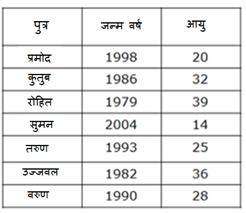
Q.2. 4
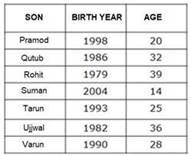
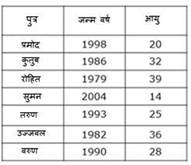
Q.3. 1


Q.4. 2

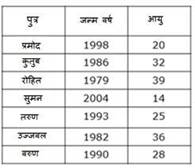
Q.5. 5
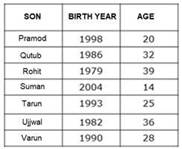

Q.6. 1
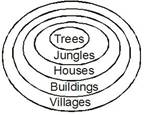

Q.7. 5

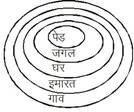
Q.8. 5


Q.9. 2
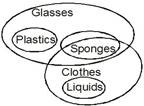

Q.10. 5


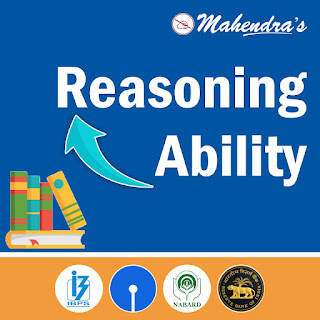




0 comments:
Post a Comment
MAHENDRA GURU